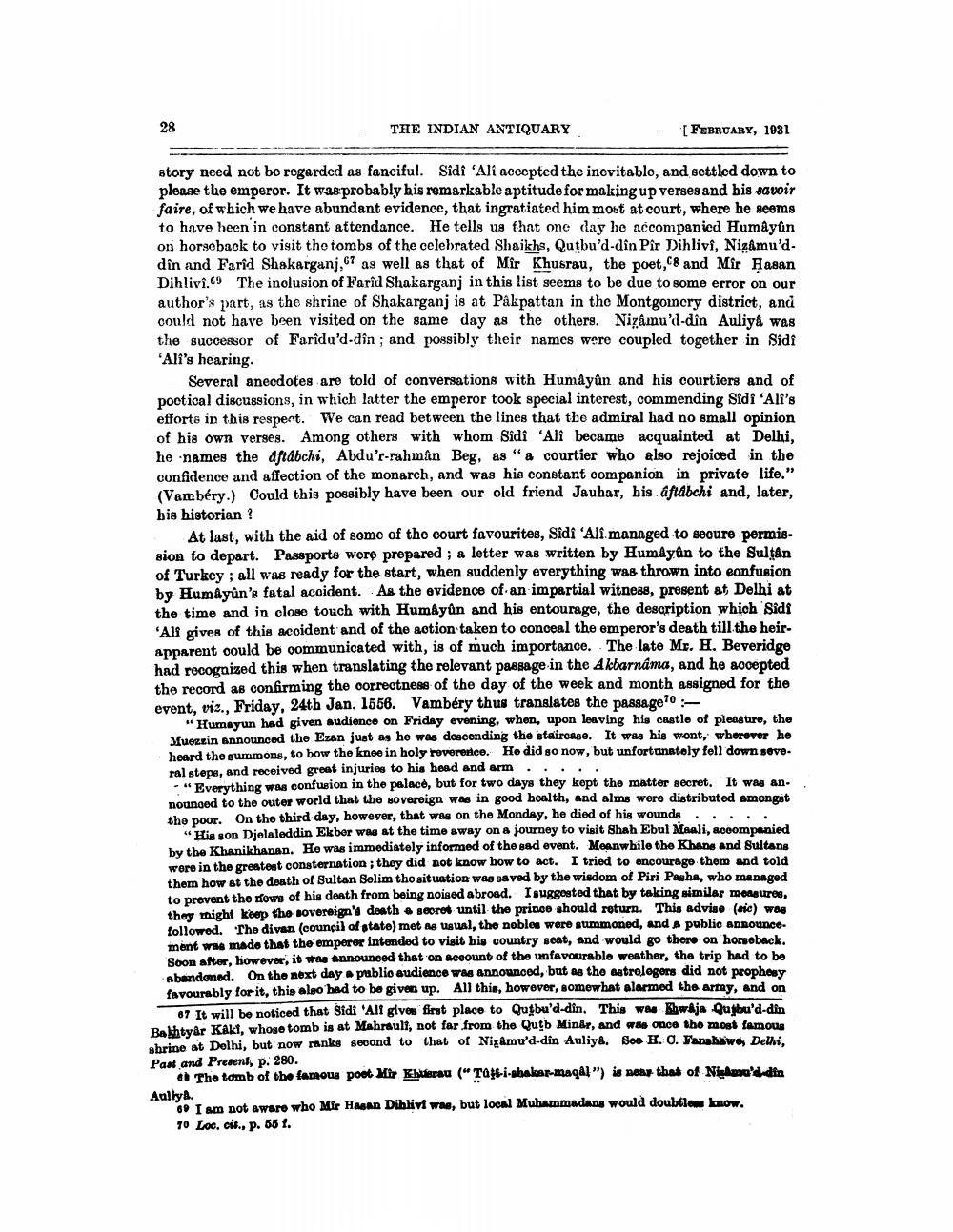________________
THE INDIAN ANTIQUARY
[ FEBRUARY, 1931
story need not be regarded as fanciful. Sidi 'Ali accepted the inevitable, and settled down to please the emperor. It was probably his remarkable aptitude for making up verses and bis savoir faire, of which we have abundant evidence, that ingratiated him most at court, where he seems to have been in constant attendance. He tells us that one day he accompanied Humayan on horseback to visit the tombs of the celebrated Shaikhs, Qutbu'd-dîn Pîr Dihlivi, Nizâmu'd. din and Farid Shakarganj,c7 as well as that of Mir Khusrau, the poet, and Mir Hasan Dihlivi.c9 The inolusion of Farid Shakarganj in this list seems to be due to some error on our author's part, as the shrine of Shakarganj is at Pakpattan in the Montgomery district, and could not have been visited on the same day as the others. Nizamu'd-dîn Auliya was the successor of Faridu'd-din; and possibly their names were coupled together in Sidi 'Ali's hearing.
Several anecdotes are told of conversations with Humayûn and his courtiers and of poetical discussions, in which latter the emperor took special interest, commending Sidi 'Ali's efforts in this respent. We can read between the lines that the admiral had no small opinion of his own verges. Among others with whom Sidi 'Ali became acquainted at Delhi, he names the aftabchi, Abdu'r-rahman Beg, as "a courtier who also rejoiced in the confidence and affection of the monarch, and was his constant companion in private life." (Vambéry.) Could this possibly have been our old friend Jauhar, his aftabchi and, later, bis historian ?
At last, with the aid of some of the court favourites, Sidi 'Alimanaged to secure permission to depart. Passports were prepared ; a letter was written by Humayûn to the Sultan of Turkey; all was ready for the start, when suddenly everything was thrown into eonfusion by Humayûn's fatal acoident. As the evidence of an impartial witness, present at Delhi at the time and in close touch with Humayun and his entourage, the description which Sidi
All gives of this accident and of the action taken to conceal the emperor's death till the heirapparent could be communicated with, is of much importance. The late Mr. H. Beveridge had recognized this when translating the relevant passage in the Akbarnama, and he accepted the record as confirming the correctness of the day of the week and month assigned for the event, viz., Friday, 24th Jan. 1656. Vambéry thus translates the passage?
"Humayun had given audience on Friday evening, when, upon leaving his castle of pleasure, the Muezzin announced the Ezan just as he was descending the staircase. It was his wont, wherover he heard the summons, to bow the knee in holy reverence. He did go now, but unfortunately fell down sove. ral steps, and received great injuries to his head and arm . . . . . - "Everything was confusion in the palace, but for two days they kept the matter secret. It was an. nounood to the outer world that the sovereign was in good health, and alms were distributed amongst the poor. On the third day, however, that was on the Monday, he died of his wounds ....
His son Djelaleddin Ekber wag at the time away on a journey to visit Shah Ebul Maali, accompanied by the Khanikhanan. He was immediately informed of the sad event. Meanwhile the Khane and Sultans were in the greatest consternation; thoy did not know how to act. I tried to encourage them and told them how at the death of Sultan Selim the situation was saved by the wisdom of Piri Pasha, who managed to prevent the news of his death from being noised abroad. I suggested that by taking similar monsures they might keep the sovereign's death a secret until the prince should return. This adviso (wie) was tollowed. The divan (council of stato) met As usual, the nobles were summoned, and public announce ment was made that the emperor intended to visit his country seat, and would go there on horseback. Soon after, however, it was announced that on account of the unfavourable weather, the trip had to be Abandoned. On the next day publio audience was announced, but as the astrologers did not peophesy favourably for it, this also had to be given up. All this, however, somewhat alarmed the army, and on
67 It will be noticed that Sidi All give first place to Qutbu'd-din. This was Khwaja Quybu'd-din Bakhtyar KALI, whose tomb is at Mahráull, not far from the Qutb Minar, and was once the most famous shrine at Dolhi, but now ranks second to that of Nizamu'd-din Auliy&. Soo H. C. Yanakaw Delhi. Past and Present, p. 280.
& The tomb of the famous poet Mir Khusrau ("Tate-i-shalar-maqal") is near that of Nig 'den Aalty.
I am not aware who Mir Hasan Dihlivi wae, but local Muhammadans would doubtlou know. 70 Loc. cit., p. 66 f.




